

TeachingEnglish. Learn English Online. TeachingEnglish. Learn English Online. TeachingEnglish. Password protected padlet. Key concepts. In the approach termed Intercomprehension between related languages the learner works on two or more languages of the same linguistic family (Romance, Germanic, Slavic languages, etc.) in parallel.

One of these languages is already known, being either the learner’s mother tongue, or the language of education, or even another language having been learnt previously. Translation activities in the language classroom. It does not consider the role of the L1 as a teaching tool, for example for classroom management, setting up activities, or for explaining new vocabulary.
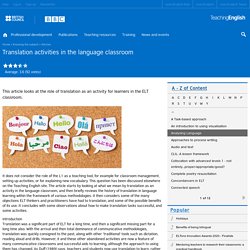
This question has been discussed elsewhere on the Teaching English site. The article starts by looking at what we mean by translation as an activity in the language classroom, and then briefly reviews the history of translation in language learning within the framework of various methodologies. From mother tongue to other tongue. This article presents the results of a survey into student attitudes towards the use of L1 in class and some suggestions for using the L1 and its culture as a learning resource.

Reinstating the mother tongue What about the learners? Survey result summary Beyond monolingualism Conclusion References Survey results in full Reinstating the mother tongue In Teaching Monolingual Classes (1993). M is for Mother tongue. In 1906 Maximilian Berlitz wrote, in the preface to his Method for Teaching Modern Languages: “In the Berlitz Method, translation as a means of acquiring a foreign language is entirely abandoned.
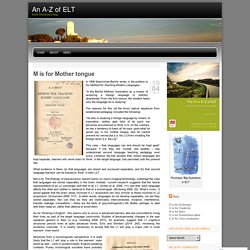
(1) David Crystal - World Englishes. The future of English. First published in 1997 for educationists, politicians, managers – indeed any decision maker or planning team with a professional interest in the development of English worldwide, the book explores the possible long-term impact on English language of developments in communications technology, growing economic globalisation and major demographic shifts at the end of the twentieth century and beyond.

TeachingEnglish. Skip to content Using multilingual approaches Using multilingual approaches is one of the 12 professional practices in the British Council's CPD framework for teachers.

It involves recognising and valuing the multilingual nature of societies, schools and classrooms, using pedagogical strategies that encourage inclusive education within a supportive multilingual learning environment, being aware of beliefs about speakers of other languages and how they can impact on establishing and maintaining an inclusive learning environment, assessing individual learners in a manner that takes their linguistic background into account, giving my learners appropriate opportunities to use their home languages to support and demonstrate their understanding of learning content, making pedagogical choices that respect and capitalise on my learners’ linguistic diversity and reflecting on how effective implementation of multilingual approaches is in promoting learning.
The future of English. Introduction to grammar. Type IPA phonetic symbols - online keyboard. 4.6_Error_correction_techniques_c_w.pdf. Password protected padlet. David Petrie: Adapting your coursebook. Very often, this happens because what is on the page doesn’t match what the learners want or need, or because what is on the page doesn’t fit with our beliefs as teachers.
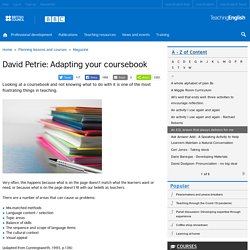
There are a number of areas that can cause us problems: Mis-matched methods Language content / selection Topic areas Balance of skills The sequence and scope of language items The cultural context Visual appeal. UN Convention on the Rights of the Child (UNCRC) The Convention has 54 articles that cover all aspects of a child’s life and set out the civil, political, economic, social and cultural rights that all children everywhere are entitled to.

It also explains how adults and governments must work together to make sure all children can enjoy all their rights. Every child has rights, whatever their ethnicity, gender, religion, language, abilities or any other status. How children learn. By Sue Clarke, teacher and trainer, British Council Introduction Your child is an individual and different from all others.
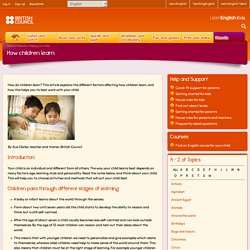
The way your child learns best depends on many factors: age, learning style and personality. Online safety for teenagers. Student Activity Sheets. Common Sense. Hot topics. Our website, like most websites, uses cookies to distinguish you from other users. This helps us to improve your experience when you browse our website and also allows us to improve our site. By using cookies, the website is essentially able to ‘remember’ you during a single visit to the site, known as session cookie or for repeat visits, known as persistent cookies. Necessary Cookies Necessary cookies enable core functionality such as page navigation and access to secure areas.
The website cannot function properly without these cookies, and can only be disabled by changing your browser preferences. Hot topics. Childnet - Childnet. Education Policy Outlook Country Profiles. Wrksht 3 Get to know the neighbours. Wrksht 2 Get to know the neighbours. Wrksht 1 Get to know the neighbours. Lesson Plan Get to know the neighbours. Student worksheet 2. Reading practice football world cup worksheet v2.
Introduction to grammar. Introduction to grammar. Introduction to grammar. Introduction to grammar. The Adventures of Kara, Winston and the Smart crew. Our website, like most websites, uses cookies to distinguish you from other users.
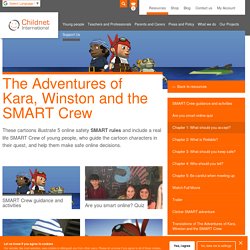
This helps us to improve your experience when you browse our website and also allows us to improve our site. By using cookies, the website is essentially able to ‘remember’ you during a single visit to the site, known as session cookie or for repeat visits, known as persistent cookies. Necessary Cookies Necessary cookies enable core functionality such as page navigation and access to secure areas. The website cannot function properly without these cookies, and can only be disabled by changing your browser preferences.
Myths about child bullying, school bullying, school phobia, no blame etc. This is the original Bullyonline website developed by the late Tim Field. It is provided as a testament to his pioneering work. Visit our new website. There's no bullying here It's in schools which say "there's no bullying here" that you are most likely to find bullying. What To Do if Your Child Is Being Bullied: 9 Steps You Can Take. As we all know too well, name–calling, cruel taunts, cyberbullying, and physical bullying happen every day to kids across the country. When your child is being bullied, it’s hard to concentrate on anything else—all you want to do is make it stop immediately. At some point, your child will be picked on or will have his feelings hurt by others.
We all have our trials and tribulations with our kids, no matter who we are. An unavoidable part of living is finding solutions to problems, even when they are not easy or comfortable. Is it because? This is a series of activities and related worksheets for you to download and use with the storybook Is it because? Learners will make an anti-bullying poster and give a presentation of the story. It forms part of the Promoting diversity through children's literature series, produced by the British Council Teaching Centre in Paris. Age. Is it because? Bullying In The Classroom: The Ultimate Guide To Stopping It. Resources to Fight Bullying and Harassment at School.
Bullying Prevention Curriculum Visit the websites below to find videos, activities, and lesson plans you can use in the classroom: Type IPA phonetic symbols - online keyboard. 4.6_Error_correction_techniques_c_w.pdf. #Learnwithtech - Twitter Search / Twitter. How students can use mobiles to learn English. Mobile technology is everywhere, but do you restrict or encourage it in your classroom? Educator, multimedia author and editor Joanna Norton shares tips about how English language teachers can use technology to their learners’ benefit.
Technology is transforming how we communicate, socialise, play, shop and conduct business. These profound changes place pressure on the traditional models of language learning, such as teaching in a formal classroom setting. They also present us with amazing opportunities to re-design the way we teach and learn English. Teaching with desktop computers vs mobile devices. High-Tech Teaching in a Low-Tech Classroom. Short courses on FutureLearn. Evaluating Technology Use in the Classroom – The Thinking Stick. Plenary session by Joy Egbert. Web 2.0 Tools for Teachers by Nik Peachey. Innovations in learning technologies for English language teaching. TeachingEnglish. 25 awesome apps for teachers, recommended by teachers. What are the best apps for teachers? We asked TED-Ed Innovative Educators and the TED-Ed community.
Below, 25 awesome apps recommended for teachers, by teachers. b459 ELTRP Report Busaidi final. OC4plan. Lesson plan. Backchannel Chat - Safe Secure Classroom Discussions. Introduction to grammar. Redirection Page. Access Denied. Introduction to grammar. Who needs resources? What type of lessons would this include. English speaking skills practice.
Lessons Worth Sharing. Learn English with apps. Self-access courses. Improve your ability to find and apply for the right jobs, develop your interview skills and learn how to perform in the workplace with confidence. Adapting materials for mixed ability classes. Online voice recorder. Free online voice recorder - SpeakPipe. Global citizenship in the English language classroom. Creativity in the English language classroom. Project work with teenagers. Research Supports Collaborative Learning. Is critical thinking a Western concept? TeachingEnglish. Project work. Introduction to grammar. Introduction to grammar.
Intrinsic motivation. Research Supports Collaborative Learning. Oxfam - Mapping Our World: Home. Introduction to grammar. Introduction to grammar.